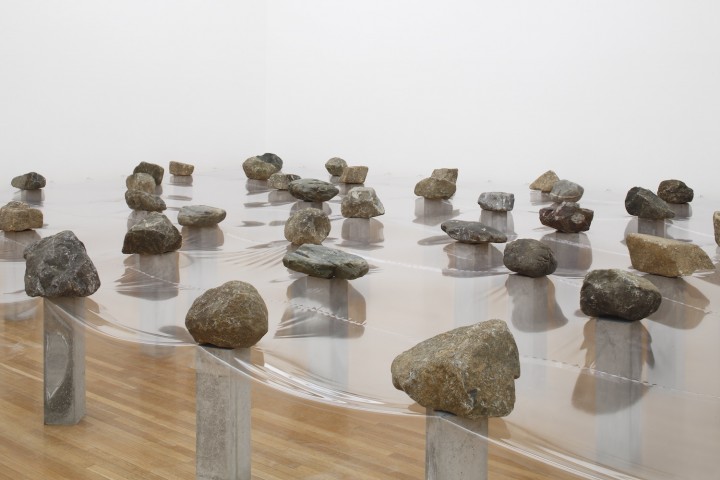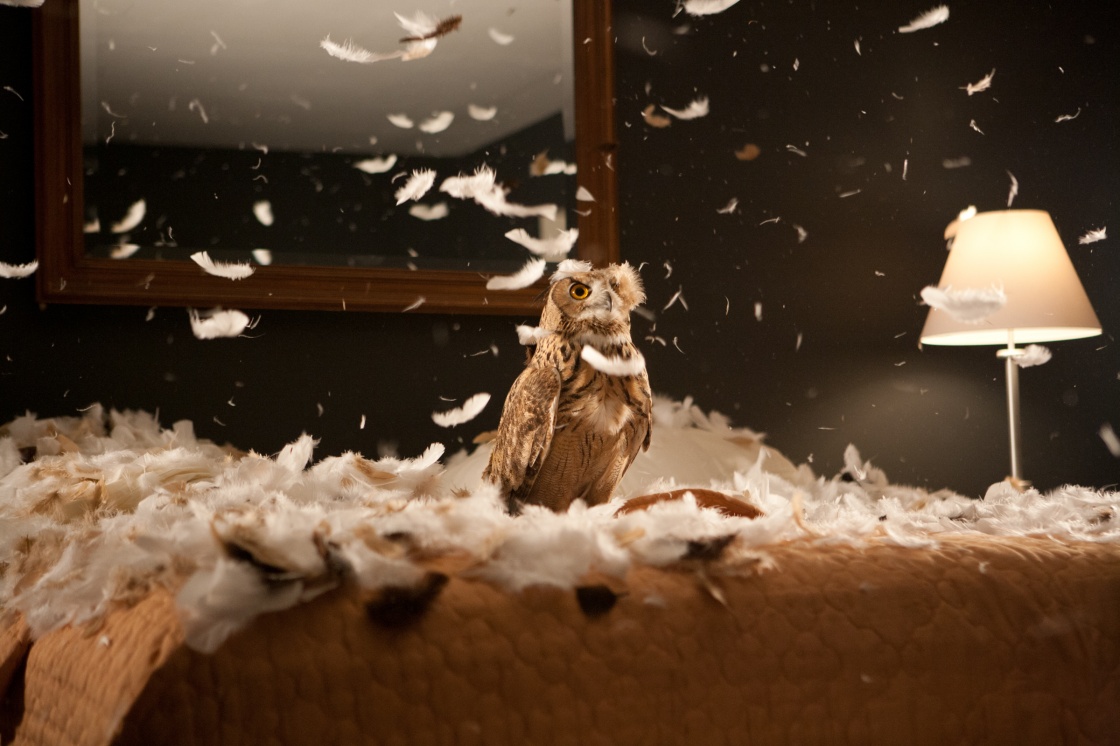September 2016

Kishio Suga. Law of Multitude. 1975. Vinyl, stones, cement blocks.
Courtesy the artist and Blum & Poe, Los Angeles/New York/Tokyo.
Kishio Suga
HangarBicocca, Milan
Opens September 29
In the late 1960s, across the world, a peculiar but powerful idea took hold among artists: maybe what really mattered wasn’t the appearance of a work of art, maybe what mattered was the making of it. In New York, Robert Morris and Richard Serra emphasized the process, rather than the look, of hanging strips of felt on a wall or chucking molten lead into a corner. The tangled spindles of the Venezuelan sculptor Gego, the British artist Richard Long’s evanescent clumps of leaves or stones, even the giant earthworks made by carving the landscape of the American west: all were the outcome of a new suspicion of form. And in Japan, a group of young artists — retrospectively grouped under the banner of Mono-ha (“School of Things”) — began to reevaluate the basic materials used to make art, and to commend both natural and industrial media for being simply what they are. A stone, a puddle, a pane of glass, a rivulet of oil: these humble, often impermanent materials were enough to make viewers see the world anew.
The Korean-born Lee Ufan is perhaps the most internationally recognized artist of Mono-ha. But the sincerest and most astute sculpture to emerge in late 1960s Japan was that of Kishio Suga — whose unaffected arrangements of rope, wood, stones, or paraffin emphasized not these materials’ formal properties, but the larger environments in which they were situated. Suga, born in 1944 and trained as a painter, sought to distill the elements he worked with into their most unadorned state. He would place a half dozen rocks on a partially submerged platform in a lake, for example, or prop open a window with a plank of ash, or balance bales of hemp twine with offcuts of the same. In many cases, viewing them was difficult: materials would be arranged such that you couldn’t see them entirely, or that your passage through the gallery was blocked. That was intentional. Visual perception was less important for Suga than comprehension of the relationships — the spatial relationships, but also the phenomenological relationships — between a thing and the world that contained it. For he doubted, from the beginning, that the function of an artwork was to let an artist express something. Suga’s art would speak for itself.
This retrospective, which will feature reconstitutions of several major, site-specific early works, will be Suga’s first in a western art institution; a second show of his opens at the Dia in New York this November. His work was seen in Italy not long ago, actually – in 2013, at the Punta della Dogana in Venice, the exhibition “Prima Materia” juxtaposed his work, and that of other Japanese artists, with the humble sculpture of Giuseppe Penone, Giulio Paolini, and other artists of Arte Povera. It’s important, though, not to let the commendable aim of globalizing postwar art history blind us to what makes Mono-ha unique. Suga and his colleagues were not just questioning the materials out of which art should be made, but the very valence of artistic creation as such. That may be hard to see now, but it was what made Suga and his compatriots the most philosophically sophisticated artists to emerge from the hot years of the late 1960s.

Southern Accent: Seeking the American South in Contemporary Art
Nasher Museum of Art at Duke University, Durham, N.C.
Opens September 1
In this upside-down presidential election even Georgia is a swing state. The idiosyncrasies and the mutabilities of the American South form the backdrop for this exhibition of 60 artists, including the photographers Carrie Mae Weems and Catherine Opie, the painters Barkley L. Hendricks and Robert Colescott, and the elegiac reminiscences of the young artist Xaviera Simmons.
11th Gwangju Biennale
Gwangju, South Korea
Opens September 2
Asia’s most important exhibition of contemporary art is organized this year by Maria Lind, chief of Stockholm’s Tensta Konsthall — who has assiduously contested the department-store sameness of shows in an era she calls “the curatorial.” Her expansive biennial takes as its theme the agency of art, and includes not just the usual roster of international artists but a pop-up school.
Daniel Richter
Louisiana Museum, Humlebæk, Denmark
Opens September 8
Are the 2000s history yet? Not long ago Richter was a leading light of German painting, and his luridly colored tableaux of ectoplasmic soldiers and monsters gummed up many a fair booth. Today his screaming mashups of art history and pop culture look passé, though he may surprise us; staging a comeback in Europe’s most beautiful museum is always a good strategy.
Doug Aitken
Museum of Contemporary Art, Los Angeles
Opens September 10
After two decades of hi-def experiential hijinks, the still boyish Californian receives his first stateside survey within museum walls. At MOCA Geffen, Aitken will exhibit his massive video works embedded in a wonderland of mazes, waterfalls, twists, and drops; it promises to be more entertaining, and to require less of a wait, than Universal Studios.

From "Foreign Gods," Leopoldmuseum, Vienna.
Carmen Herrera
Whitney Museum of American Art, New York
Opens September 16
Slow and steady. Still working at 101, the Cuban-American painter receives her first New York retrospective since the revelatory 1998 show at El Museo del Barrio. Herrera’s hard-edged compositions, which feature just two or three colors in precisely divided zones, carry forward a tradition of Latin American abstraction, but there’s a joy and extemporization to Herrera’s art that is echt New York.
Foreign Gods
Leopold Museum, Vienna
Opens September 23
Without African and Oceanic art there is no modernism — but time and again, notoriously at MoMA in 1984, attempts to place western painting alongside the “primitive” sculpture that inspired it have fallen short. This modernist museum is giving the theme another go, and will draw on its own collection of central African masks and statuary alongside Picasso, Derain, Kirchner, and company.
The Artist
Moderna Museet, Malmö
Opens September 24
A simple title for a complex social question: is an artist a courtier or an outsider, a craftsman or a spiritualist, a researcher or a prophet? This intriguing, centuries-spanning group show, organized in collaboration with Sweden's Nationalmuseum, examines the mythology and social positions of the world's image-makers, from Rubens and Rosa Bonheur to Hilma af Klint and Cindy Sherman.
Los Angeles to New York: Dwan Gallery, 1959–1971
National Gallery of Art, Washington
Opens September 30
The influential gallerist and philanthropist helped launch the careers of Ad Reinhardt, Sol LeWitt, Carl Andre, and Robert Smithson. Three years ago she bequeathed 250 works from her personal collection to this museum, which will display a hefty fraction of her gift in its newly renovated East Building. Travels to LACMA in March.